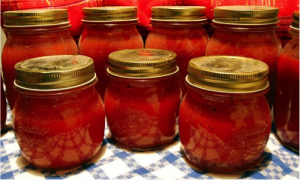 You’ve heard us say it before – vegetables and other low acidity foods must be canned in pressure canners in order to reach temperatures high enough to kill harmful microorganisms that would otherwise grow. Many consumers typically think of tomatoes as highly acidic foods. However, due to several factors, including ease in harvesting and consumer demand, tomatoes are now bred to have a lower acidity than they once did.
You’ve heard us say it before – vegetables and other low acidity foods must be canned in pressure canners in order to reach temperatures high enough to kill harmful microorganisms that would otherwise grow. Many consumers typically think of tomatoes as highly acidic foods. However, due to several factors, including ease in harvesting and consumer demand, tomatoes are now bred to have a lower acidity than they once did.
Participants in our home food preservation classes are usually surprised to learn that tomatoes need to be further acidified for safe canning! Tomatoes have a pH between 4 and 4.6. Because of their varying acidity, we can only be sure that tomatoes have been safely canned when they have been acidified. The following chart indicates how much acid must be added to tomatoes.
Note that the lemon juice option specifies using bottled lemon juice. Fresh lemons may also have varying acidity, so using bottled lemon juice offers consistency in the pH of the product.
Other options for acids include citric acid and vinegar. Vinegar may cause a change in flavor of your product. Acidification is required whether you are water bath canning tomatoes or pressure canning them.
Tomatoes are one of the most popular home-canned items. Be sure you are canning tomatoes safely by acidifying them. For more information about preserving tomatoes, visit Ohioline to read OSU Extension’s Fact Sheets on Canning Tomatoes(PDF) and Canning Tomato Products(PDF).
Written by: Joanna Rini, Extension Educator, Family and Consumer Sciences, Ohio State University Extension – Medina County, rini.41@osu.edu
Reviewed by: Lisa Barlage, Extension Educator, Family and Consumer Sciences, Ohio State University Extension – Ross County
Sources:
http://ohioline.osu.edu/hyg-fact/5000/pdf/HYG_5336_15.pdf
http://www.clemson.edu/extension/food_nutrition/canning/tips/27tomato_products_acidify.html

